- Submissions

Full Text
Clinical Research in Animal Science
Amplitude and Frequency Modulation-A Characteristic of Canine Soundgrams
Violeta Alexandrova* and Pavlina Spiridonova
University of Forestry, Faculty of Veterinary Medicine, 10 Kliment Ohridski Blvd, Sofia, Bulgaria
*Corresponding author: Violeta Alexandrova, University of Forestry, Faculty of Veterinary Medicine, 10 Kliment Ohridski Blvd, Sofia, Bulgaria
Submission: August 10, 2021;Published: September 20, 2021

ISSN: 2770-6729Volume 1 - Issue 5
Abstract
The present research aims to discover the amplitude-frequency characteristic of 102 recorded and prepared soundgrams of 6 dogs associated with different and concrete behavioral reactions.
Keywords: Soundgram; Computer analysis; Amplitude; Frequency modulation
Introduction
To discriminate one tone from a noise, the first has to hold one fundamental tone - the simple tone with the largest amplitude and lowest frequency, and few overtones, with parameters multiple of the fundamental tone’s, within its spectral bandwidth. The noise as sound wave is consisted of chaotic a periodically varying tones [1].
Sound loudness is characterized by the wave amplitude along its spectrum. It is measured in decibels (dB). The frequency of sound defines its pitch, measured in hertz (Hz). In practice it is more convenient to work with high frequency short wavelength waves, than with low pitched long wavelength sounds [2].
Analyzing different animal communicative signals, we compare mainly their amplitude and frequency characteristics. After a lot of research, we assume that animals and dogs in particular, code their signals predominantly in these two modulations - by dB and Hz. Following the sound along its bandwidth in amplitude-frequency relation, we are able to segment the signal into so called “modules”, analogous to “syllables” in human language [3]. Most suitable for this aim is the bandwidth of a sound gram.
The other commonly used methods-spectrograms and waveforms of the sound signals, give only limited information about the sound elements. These methods benefit mainly the quantitative and visual assessment of the signal, neglecting the details. In other words spectrograms and waveforms picture only the macrostructure of the sound. Our main effort is to unravel the codes within the canine communication signals by revealing the microstructure, the micro fragments that construct them [4].
According to Fitch [5], the evolution of speech can be studied independently of the evolution of language, with the advantage that most aspects of speech acoustics, physiology and neural control are shared with animals, and thus open to empirical investigation. At least two changes were necessary prerequisites for modern human speech abilities:
1) modification of vocal tract morphology, and
2) development of vocal imitative ability.
Kohonen self-organizing neural networks, also called self-organizing maps (SOMs), have been used successfully to recognize human phonemes and in this way to aid in human speech recognition. This paper describes how SOMs also can be used to associate specific information content with animal vocalizations [6].
Material and Methods
For the aim of decoding animal communication sounds, expressed in soundgrams, we used computer analysis with computer extension. Database was registered and presented on oscillographic curve. Frequency of the sounds is measured (in Hz) as well as their intensity fluctuations (in dB).
The results from 102 soundgrams of 6 dogs in different and concrete behavioral reactions were registered, prepared and described.
We needed a technical solution which allows a detailed picture of the biphasic amplitude of the periodic sound fluctuations and the pause in between.
Our goal was accomplished, and we succeeded to follow in details different sound oscillations in the bandwidth specter, and thus to receive the visual idea of modulated syllable encoded in the signal.
Result
Clear variations in frequency (Hz) and intensity (dB) values of the examined animal sounds were registered during our acoustic analysis.
The results we summarized as follows:
A. In association with sound oscillations frequency (Hz): average frequency value; lowest and highest frequency value;
B. In association with sound oscillations intensity (dB): average values for the highest and the lowest intensity fractions; lowest and highest amplitude value from the recorded sound signals.
The average frequency rate (Hz) of examined acoustic materials in different and concrete behavioral reactions in dog is 979.48Hz. Frequency range of the record in Figure 1 marks close to the average frequency range registered in different and concrete behavioral reactions in dogs-around 242Hz. There are low amplitude sharp peaked fluctuations on the recorded signal.
Figure 1: Average frequency value of sound oscillations (Hz) in dog.
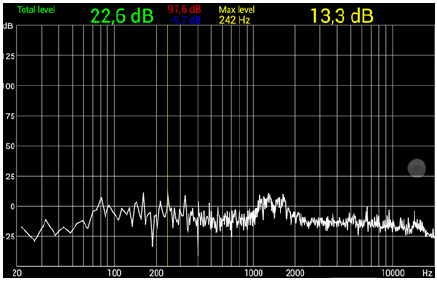
In comparison the record from Figure 2 shows the lowest registered frequency value in canine sound signal - approximately 81Hz. Fluctuations in the record are clear, forming groups.
Figure 2: The lowest frequency value of sound oscillations (Hz) in dog.
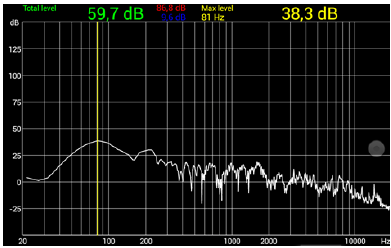
The sound fraction of Figure 3 describes the highest frequency rate-approximately 2912Hz. On the record are expressed also sharp peaked low amplitude and low frequency packs of oscillations.
Figure 3: The highest frequency value of sound oscillations (Hz) in dog.
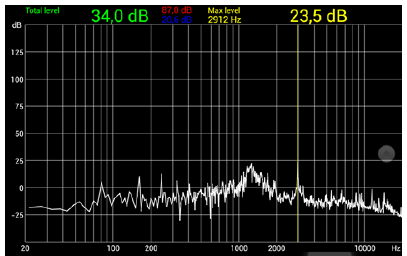
Average amplitude value of the sound fluctuations (dB) in different and concrete behavioral reactions in the recorded 102 soundgrams is 47.87dB.
Figure 4:Average amplitude value of sound oscillations (dB) in dog.
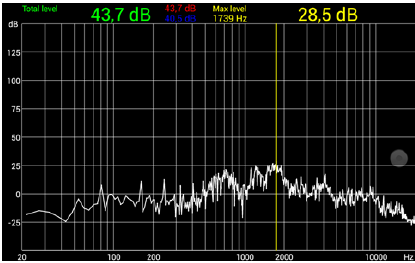
Amplitude range of the record on Figure 4 corresponds to the average amplitude value of the canine decibel diapason in concrete behavioral reactions - it varies between 28.5-43.7dB. There are low amplitude sharp peaked oscillations of the sound, forming prolonged plateau.
In contrast, the record from Figure 5 marks the lowest amplitude values-varying between 10.4 and 20.8dB. Sharp peaked fluctuations are close to the average numbers of frequency in canine sound signals.
Figure 5:The lowest amplitude value of sound oscillations (dB) in dog.
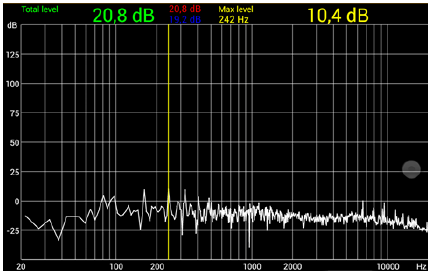
Figure 6 shows the highest amplitude rates - between 45,3 and 62,9dB. Intriguing is the fact that amplitude and frequency values here are in reversed relations.
Figure 6:The highest amplitude value of sound oscillations (dB) in dog.
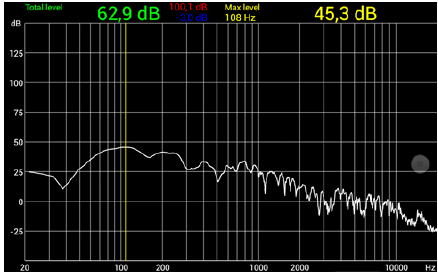
Discussion
In human language the sound gram displays every syllable from a phrase, registered as discrete submodules. Each submodule owns unique pattern - form, amplitude and frequency characteristics with pauses in between [7,8].
Authors assume that animals with highly developed glottis (vocalization) use synthesis (impulse modulation) when modeling sound waves along the bandwidth. They define these as “modules”. Each module could be consisted of different number of “submodules” and additional oscillations with varying amplitude and frequency. Then some specific for human language terms could be used to describe modules and submodules respectively as syllables and phonemes.
Language codes depend on the duration and different combinations between modules and their spatial arrangement across the bandwidth as well. Thus, the phrases (similar or different modules combined together) and the themes (packs of similar or different in their structure phrases) are formed in the animal communication vocalizations. Presented as soundgrams these language codes are accurately and precisely displayed and allow detailed analysis.
The same authors describe a dog’s soundgram, consisted of two modules - a and b [9].
Placer et al. [10] do research on communication signals of prairie dogs associated with certain predator. They cut each of the recorded calls on equal fragments and choose those four fragments of each record that are with the highest frequency. The two lowest frequencies out of this group of four, they define as representative acoustic units for each signal. The analysis shows unique pattern. Alarm calls which prairie dogs use encode specific combinations of acoustic models according to the species of the predator.
The acoustic structure of communication signals in canines shows specific contextual motives, light motives. The aggressive, dominant, annoyed canine barks always have low energy (frequency), whereas playful, friendly barks appear mostly as high pitched (Yin, 2002).
Zeng et al. [11] in their research from 2005, affirm the significance of the amplitude-frequency modulation in human language recognition. They even define it as essential in such type of analysis. They prove that frequency modulation gives adequate results even in noisy environment, which cause many artifacts in traditional methods for speech recognition. Frequency-amplitude characteristics improve significantly the acoustic analysis. In their work scientists use “fast” and “slow” frequency modulation to follow sound resonance and word formation during speech production process in mouth. Nevertheless, these examinations are conducted on humans and specify human language, this methodology could be promising in bioacoustic analysis of animal communicative vocalizations.
Kostov et al. [9] register sound frequency of about 1050Hz on a recorded canine communication signal which matches with registered from us frequency range in the same animal species. Spiridonova et al. [12] report some amplitude and frequency data associated with concrete behavioral reactions in canines. Kohonen used a SOM to create a recognition system for human speech that could detect phonemes from a continuous speech signal [13].
Conclusion
1. The applied method allows reading the sound signals in dynamics and thereby an accurate and precise visual idea of the modulated syllable encoded in the signal is achieved.
2. Such methodology successfully decodes even the tiniest pattern in canine communication signals, presented in sound grams, in different and concrete behavioral reactions.
3. The data collected through the sound gram analysis can serve as a baseline in the classification of bioacoustic vocalizations.
References
- Todorov V (2002) Medical physics. "VM-OFSET", Sofia, Bulgaria, pp: 7-33.
- Brown C, Riede T, Budney GF, Clemins PJ, Goller F, et al. (2017) Comparative bioacoustics: An overview. Bentham Science Publishers, Sharjah, UAE.
- Kostov Y, Alexandrova V (2010) How animals talk (soundgrams, spectrograms). PH "Eniovche", Sofia, Bulgaria, p. 120,
- Taylor AM, Reby D, McComb K (2009) Context-related variation in the vocal growling behaviour of the domestic dog (Canis familiaris). Ethology 115(10): 905-915.
- Fitch WT (2000) The evolution of speech: a comparative review. Tends in Cognitive Sciences 4(7): 258-267.
- Placer J, Slobodchikoff CN, Burns J, Placer J, Middleton R (2006) Using self-organizing maps to recognize acoustic units associated with information content in animal vocalizations. animal studies repository. J Acoust Soc A 119(5 Pt 1): 3140-3146.
- Kostov Y, Alexandrova V (2009) How to recognize (decode) animal language. Bulgarian Journal of Agricultural Science 15(5): 475-477.
- Kostov Y, Alexandrova V (2011) Methods for decoding and demodulating of the animal’s language. Journal of Animal Science 48(2): 38-42.
- Alexandrova V, Kostov Y (2010) Language soundgrams of some domestic animals and birds. Journal of Animal Science 47(1): 64-68.
- Placer J, Slobodchikoff C (2004) A method for identifying sounds used in the classification of alarm calls. Behavioural Processes 67(1): 87-98.
- Zeng F, Nie K, Stickney G, Kong Y, Vongphoe M, et al. (2005) Speech recognition with amplitude and frequency modulations. Proceedings of the National Academy of Sciences of the United States of America 102(7): 2293-2298.
- Spiridonova P, Alexandrova V (2020) Evidence for accuracy of applied method in decoding sound signals. Tradition and Modernity in Veterinary Medicine 5N2(9): 65-69.
- Kohonen T (1988) The ‘neural’ phonetic typewriter. Computer 21: 11-22.
© 2021 Violeta Alexandrova. This is an open access article distributed under the terms of the Creative Commons Attribution License , which permits unrestricted use, distribution, and build upon your work non-commercially.
 a Creative Commons Attribution 4.0 International License. Based on a work at www.crimsonpublishers.com.
Best viewed in
a Creative Commons Attribution 4.0 International License. Based on a work at www.crimsonpublishers.com.
Best viewed in 







.jpg)






























 Editorial Board Registrations
Editorial Board Registrations Submit your Article
Submit your Article Refer a Friend
Refer a Friend Advertise With Us
Advertise With Us
.jpg)






.jpg)














.bmp)
.jpg)
.png)
.jpg)










.jpg)






.png)

.png)



.png)






